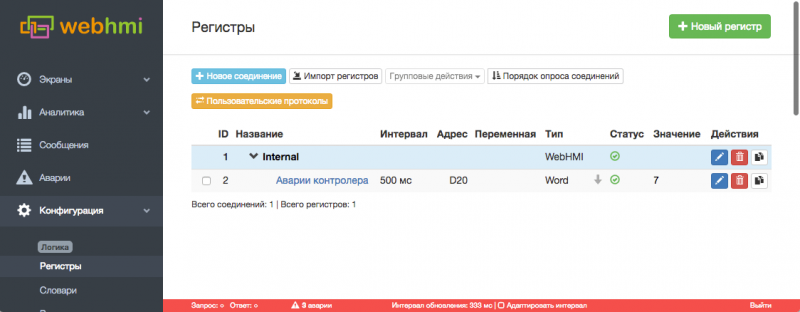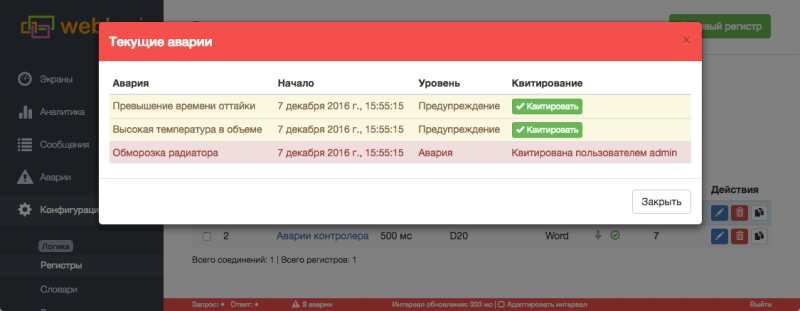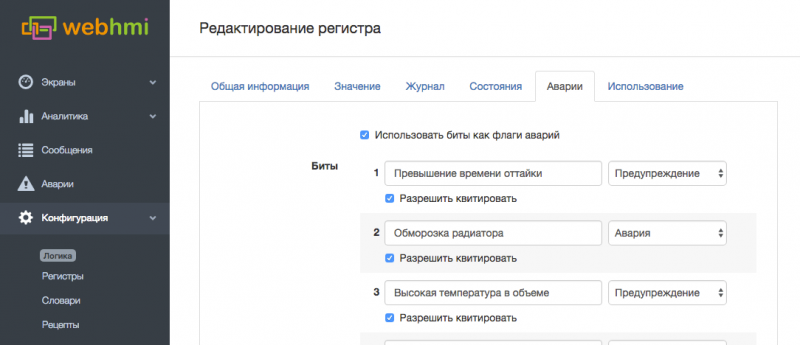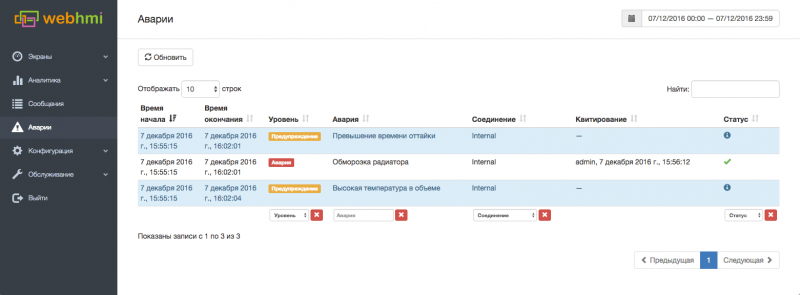Аварии/en — различия между версиями
(Новая страница: «Usually alarms in the PLC are organized as a set of bits in any of the registers. Each bit is the flag of a single alarm. In WebHMI alarms are configured in the r…») |
(Новая страница: «Past alarms can be viewed in the alarm log. 800px») |
||
| (не показаны 4 промежуточные версии этого же участника) | |||
| Строка 4: | Строка 4: | ||
Usually alarms in the PLC are organized as a set of bits in any of the registers. Each bit is the flag of a single alarm. In WebHMI alarms are configured in the register editor, i.e. a register or group of registers can be allocated for handling accidents. This makes it convenient to transfer them from the project to the project and from the connection to the connection when they are cloned. If any of the devices has a different format for representing the alarms, for example, for each type of alarm a separate register, or an alarm code with a combination of a bit flag, etc. - such alarms can be brought to the standard way by using the capabilities of scripts on Lua, having generated the alarm bits in the internal register. | Usually alarms in the PLC are organized as a set of bits in any of the registers. Each bit is the flag of a single alarm. In WebHMI alarms are configured in the register editor, i.e. a register or group of registers can be allocated for handling accidents. This makes it convenient to transfer them from the project to the project and from the connection to the connection when they are cloned. If any of the devices has a different format for representing the alarms, for example, for each type of alarm a separate register, or an alarm code with a combination of a bit flag, etc. - such alarms can be brought to the standard way by using the capabilities of scripts on Lua, having generated the alarm bits in the internal register. | ||
| − | + | Any of alarms can be allowed to be acknowledged. This allows you to tell the system that the operator is aware of its occurrence. Also for the alarm you can set its level - Information, Warning, Accident. | |
| − | + | In the initial state, the "Alarms" side menu item is empty, crashes there will only appear after creating at least one register with alarm bits in the project. | |
[[Файл:Alerts-add.png | 800px]] | [[Файл:Alerts-add.png | 800px]] | ||
| − | + | When an alarm occurs, the system will turn the status bar to red. The line will blink periodically to attract attention. Also, if there are unqualified alarms, an audible alarm will be issued every 15 seconds. | |
[[Файл:Alerts-footer.png|800px]] | [[Файл:Alerts-footer.png|800px]] | ||
| − | + | To view the current alarms, you can click on the text with the alarms in the status line. This will open a pop-up window with a list of current crashes. In this window you can see their list, the time of the occurrence of the alarm, acknowledge the alarm, see the login of the user who acknowledged the alarm. | |
[[Файл:Alerts-acknowledge.png|800px]] | [[Файл:Alerts-acknowledge.png|800px]] | ||
| − | + | Also, using Lua programs, you can perform certain actions depending on the current alarms. For example, you can send SMS messages if there are alarms that have not been acknowledged for more than 10 minutes. Or any other action. An example of handling an alarm list is [http://wiki.webhmi.com.ua/index.php/%D0%A1%D1%86%D0%B5%D0%BD%D0%B0%D1%80%D0%B8%D0%B8_LUA#GetCurrentAlerts.28.29 here] | |
| − | + | Past alarms can be viewed in the alarm log. | |
[[Файл:Alerts-log.png|800px]] | [[Файл:Alerts-log.png|800px]] | ||
Текущая версия на 11:47, 21 ноября 2017
In WebHMI there is the concept of an alarm. An alarm is a state of the system that requires human attention. WebHMI signals all alarms visually (red status bar on the dashboards) and an audible signal about unqualified accidents. Emergencies are logged for later analysis.
Usually alarms in the PLC are organized as a set of bits in any of the registers. Each bit is the flag of a single alarm. In WebHMI alarms are configured in the register editor, i.e. a register or group of registers can be allocated for handling accidents. This makes it convenient to transfer them from the project to the project and from the connection to the connection when they are cloned. If any of the devices has a different format for representing the alarms, for example, for each type of alarm a separate register, or an alarm code with a combination of a bit flag, etc. - such alarms can be brought to the standard way by using the capabilities of scripts on Lua, having generated the alarm bits in the internal register.
Any of alarms can be allowed to be acknowledged. This allows you to tell the system that the operator is aware of its occurrence. Also for the alarm you can set its level - Information, Warning, Accident. In the initial state, the "Alarms" side menu item is empty, crashes there will only appear after creating at least one register with alarm bits in the project.
When an alarm occurs, the system will turn the status bar to red. The line will blink periodically to attract attention. Also, if there are unqualified alarms, an audible alarm will be issued every 15 seconds.

To view the current alarms, you can click on the text with the alarms in the status line. This will open a pop-up window with a list of current crashes. In this window you can see their list, the time of the occurrence of the alarm, acknowledge the alarm, see the login of the user who acknowledged the alarm.

Also, using Lua programs, you can perform certain actions depending on the current alarms. For example, you can send SMS messages if there are alarms that have not been acknowledged for more than 10 minutes. Or any other action. An example of handling an alarm list is here

